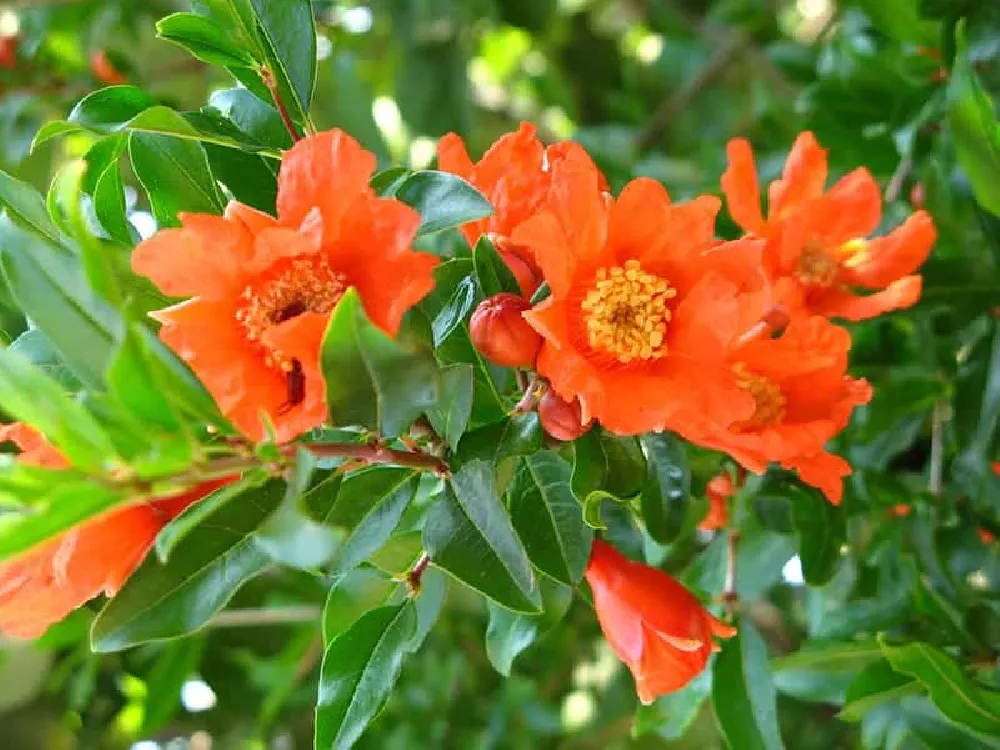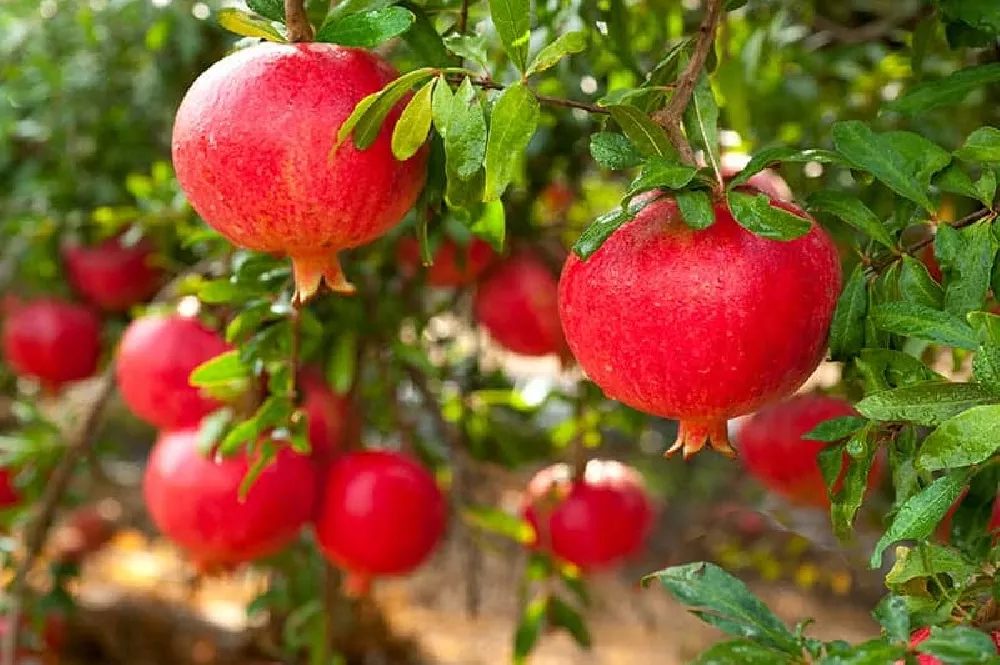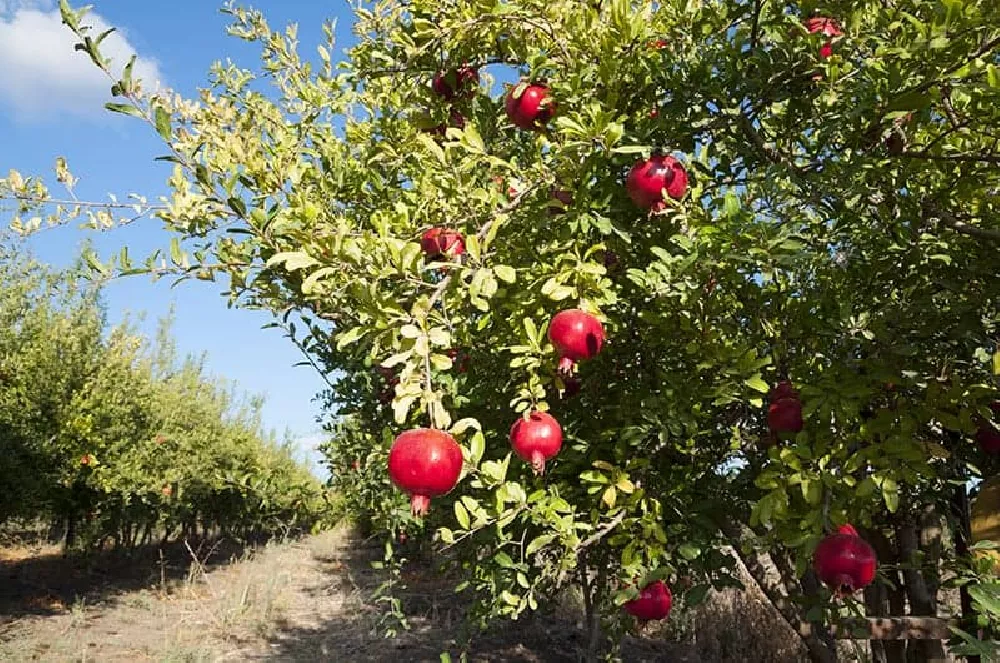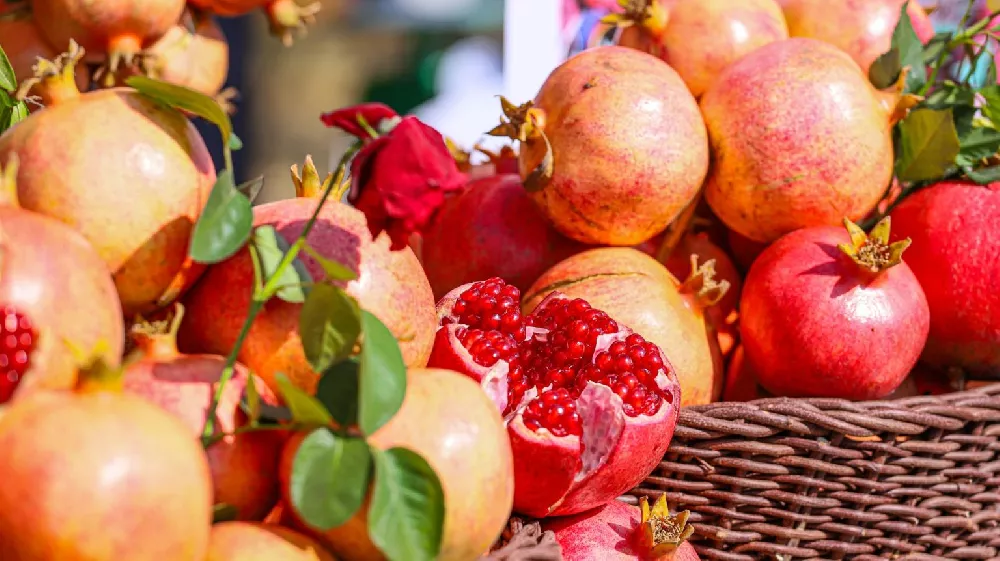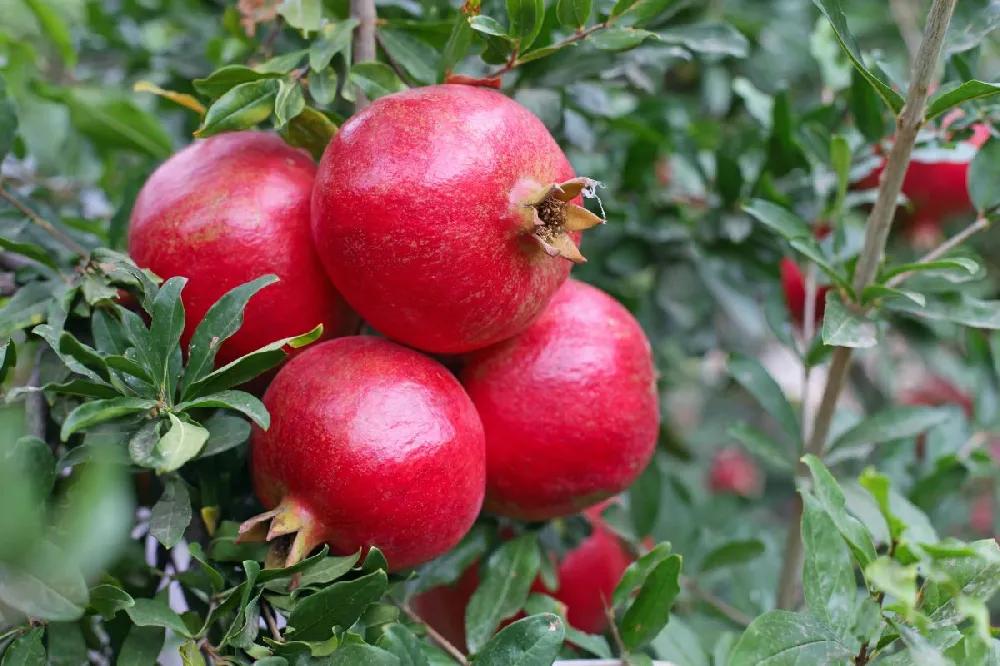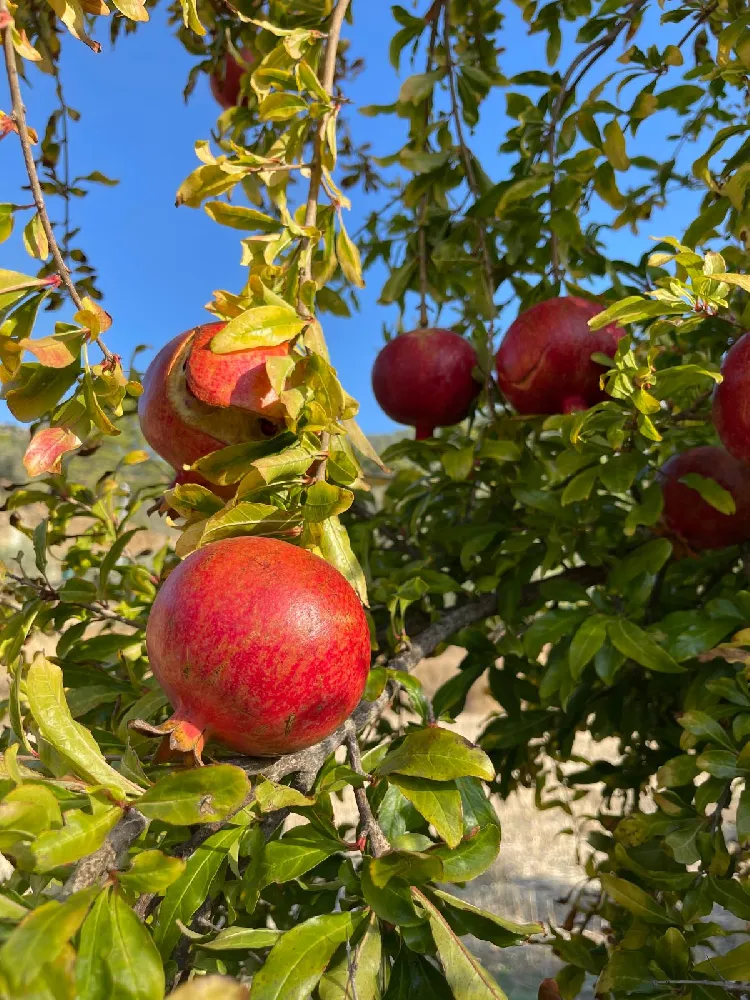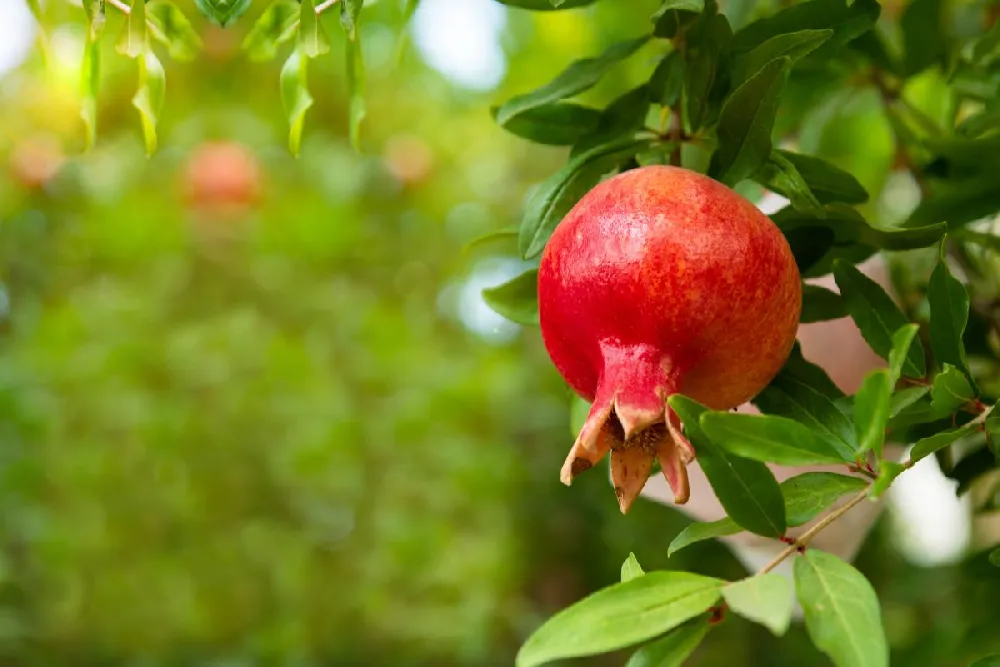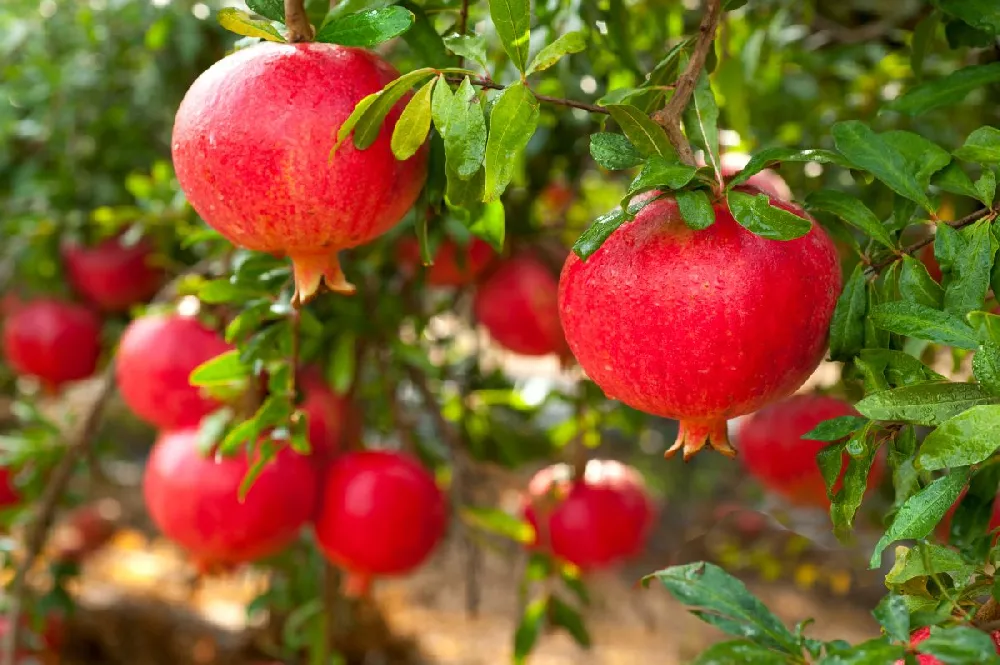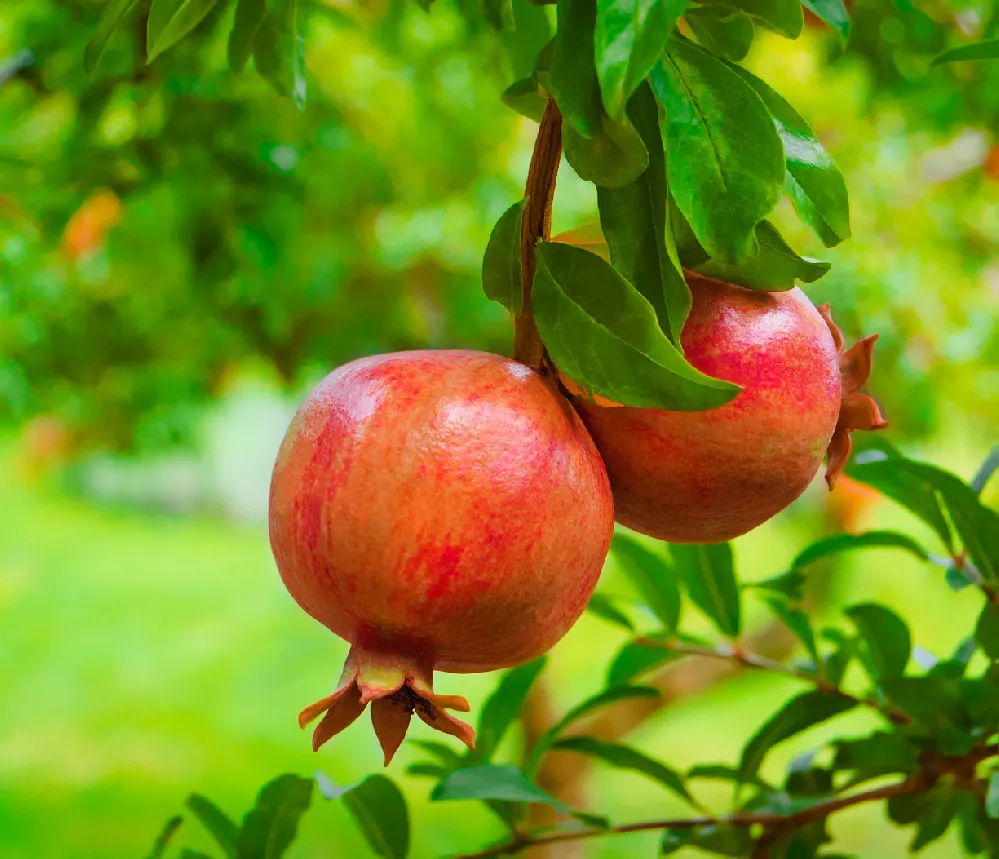- Home >
- Edible Plants >
- Sweet Pomegranate Trees
Sweet Pomegranate Trees for Sale
The Sweet Pomegranate Tree (Punica granatum ‘Sweet’) is one of the loveliest and smartest additions you can make to a sunny warm garden. The tree is easy to care for, aesthetically beautiful, and produces one of the healthiest, most delicious fruits available. Here are some other interesting facts about Sweet Pomegranate Trees:
- Are suitable for planting in either a garden or a large container.
- Grow best in coastal growing zones.
- Produce notably sweet and juicy fruit.
Enter your zip code to find nearby stores that may carry this plant.
Plant Care
Sunlight

Thrives with 6 or more hours of direct sunlight each day.
Watering
Water regularly during the growing season so that soil stays moist around the root zone.
Fertilizing

Fertilize plants after a full year of growth with a light dressing of a balanced, slow-release product, such as 10-10-10 fertilizer.
Planting and Care
Planting instructions
Sweet Pomegranate Trees thrive in growing zones 7-10. Plant them in early spring or later in the fall to reduce stress and help acclimate the plants to their soil and sun exposure. The best location is in a spot that gets several hours (six or more hours) of direct sunlight each day. If you’re in a cooler climate, choose a spot that offers protection from the wind. The soil must have good drainage, and many experts suggest digging a hole a day or two before planting and filling it with water to ensure that the water drains completely within an hour.
Plant Sweet Pomegranate Trees in a hole twice the width of the root ball. The top of the root crown should be at ground level. If you are planting a bare root tree, soak the roots in a bucket for a few hours before planting. The hole should be big enough to accommodate the roots without bending them. Before filling the hole add some compost or composted manure.
The Sweet Pomegranate Tree also does well in a container as long as it is deep enough and has sufficient drainage holes. Do not choose a self-watering pot. In the winter, bring the container inside and keep it in a basement or another cool area to ensure that your tree has the opportunity to go into dormancy.
Watering and nutrients
Sweet Pomegranate Trees are considered drought-tolerant and do not need watering every day. They do require deep watering to make sure that the root ball itself and the soil surrounding it remain moist, especially at the height of the summer’s heat. The goal is to keep the soil around the tree moist as its fruit is ripening. A plant that does not get sufficient water will drop its fruit prematurely or have fruit that splits on the branches, while overwatering can lead to root rot, and can also lead to fruit splitting. Placing a layer of organic mulch around the tree’s base — but not at its trunk, which needs air circulation — will help retain moisture. Once the summer’s heat has passed and cooler temperatures arrive, reduce watering.
A newly-planted Sweet Pomegranate Tree requires extra water through its first year. The same is true for trees planted in containers. The best way to check a potted pomegranate tree’s moisture needs is to stick your finger 4 to 5 inches into the soil once a week to test for dryness. If the soil is dry, drench your plant until water drains out of the drainage holes. Do not allow a Sweet Pomegranate Tree planted in a container to sit in a drainage tray full of water.
Sweet Pomegranate Trees require little in the way of nutrients or fertilizer. Do not fertilize newly-planted pomegranate trees. Begin fertilizing after a full year of growth. For container plants, apply an organic plant fertilizer with an NPK of 10-10-10 or 20-20-20, or a slow-release shrub and tree fertilizer containing nitrogen. Keep in mind that too much fertilizer will increase foliage and decrease fruit.
Pruning
The Sweet Pomegranate Tree is healthiest and will produce the greatest amount of fruit when it is kept to a compact shape. Pruning should not be done at all during the tree’s first year. Once this period has passed, you can prune each year before new leaves appear in the spring. A pomegranate can be shaped as a bushy, multi-trunk shrub, or as a single or multi-trunk tree, based on your personal preference.
Dead and damaged stems are best removed in late fall as the tree enters its dormant season. Suckers should be cut off at ground level as soon as they appear. When pruning, keep in mind that the Sweet Pomegranate Tree’s fruit form on second-year wood, so you need to avoid cutting too far back. At the same time, the more light and air your tree’s flowers get, the more fruit will develop. Most fruit will appear on the outside of the tree, so pruning toward the inside growth will accomplish your fruit production goals.
Harvesting
The Sweet Pomegranate Tree yields fruit a bit earlier than other varietals, with fruit ripening from August through September. The best time to pick fruit is just as it is about to turn ripe, as it will not ripen once you remove it from the tree. There are several ways to tell whether a pomegranate is ripe, including watching the shape of the fruit itself. Fruits develop a hexagonal shape as seeds increase in size. Ripe fruit will often split or fall off the tree. Another good indication of whether the fruit is ready is to tap on it. If you hear a metallic sound, it is ready to pick. Do not pull the fruit off of the tree to harvest it, as that can damage it. Use hand pruners or a sharp knife. Make the cut as close to the fruit as possible.
Pests, diseases, and animals
Most Sweet Pomegranate Tree diseases arise from overly wet soil, and are most likely to affect the fruit rather than the tree. Many diseases will lead to splitting or rot. These include Alternaria fruit rot and Aspergillus fruit rot. Both diseases rot the fruit on the inside. Pomegranate trees are also vulnerable to Botrytis infections, which is a gray mold that often infests tropical fruit trees when they are flowering. A copper fungicide will address most fungal issues. There is another disease known as Cercospora fruit spot that causes black spots on the outside of the fruit as well as the twigs of the tree, and causes the tree to lose its leaves. If you see this, the diseased areas should be removed and the copper fungicide applied.
Pests, including aphids, mealybugs, whiteflies, scale insects, and beetles, are also an issue that impacts pomegranates. The first sign of infestation is usually yellow, wilting leaves or damage to the fruit. Though chemical pesticides are effective, they can also harm bugs that help the trees. The best approach is to inspect plants regularly, and then apply insecticidal soap early on. An insecticidal soap will kill the insects on contact. Oil sprays can also work but should not be applied when temperatures are above 85 degrees Fahrenheit.
Light
Pomegranate trees need full sun to produce an abundance or large and juicy fruits. While the tree will grow in shade, it will grow at a slower pace, and the fruits it produces will be small and slightly dry. Ensure you plant your tree in a position where it will receive sunlight for most, if not all, of the day. If your pomegranate is grown in a pot, you can move it around as the seasons change to make sure it is always recieving optimum sunlight.
Temperature
Pomegranates originally hail from tropical regions, and so, are best suited to warm and hot climates. An ideal temperature range for growing pomegranate trees is between 40 and 90 degrees Fahrenheit. If you live in a suitably warm climate, then pomegranate trees are one of the most rewarding fruiting trees you can grow. If you live in a cooler region, you could try your hand at growing a pomegranate tree indoors, which should be reasonably successful provided you position it in a spot with plenty of light.
While the tree does prefer to be kept warm, it is mildly frost-tolerant. It can cope with temperatures as low as 15 degrees Fahrenheit, but only for short periods of time. If it is kept in these conditions for too long, it will suffer from leaf drop and may even die.
Humidity
Pomegranates enjoy high humidity, though this is difficult to control in an outdoor environment. Maintaining moist soil will help to increase humidity. As the water evaporates from the soil, it will increase the moisture content of the air. The tree is ideally suited to naturally humid climates, but if you grow the plant indoors, you can artificially increase humidity by misting the plant or using an electric humidifier.
Propagation
If you have a pomegranate tree and would like to grow more of that variety, you can easily do so by propagating with cuttings. This is preferable to growing from seed as it takes less time, and the result is predictable. You can grow pomegranate trees from seed with success, but unpredictable genetic variations can occur, so you cannot reliably know what sort of pomegranate tree you will end up with. In some cases, you may end up with one that bears inedible fruits.
By growing from cuttings, you guarantee that the new plant will be of the same variety as the mother plant. To achieve this, take a semi-hardwood cutting of around 15 inches from your pomegranate tree. Dip the cut end in rooting hormone, remove any lower stems or foliage, and plant it into well-draining potting soil. You could plant it directly into the ground outside or into a container. The best time to do this is in very early spring, when the plant is just gearing up to have a period of increased growth. This timing will also mean that the plant has enough time to develop a good root system, so it is strong enough to get through a frosty winter (Royal Horticultural Society).
FAQs
When will my Sweet Pomegranate Tree produce fruit?
Do I need to have two (or more) Sweet Pomegranate Trees to get fruit?
The Sweet Pomegranate Tree is self-pollinating, so no additional trees are needed, but experts say that having more than one tree will increase the amount of fruit that each tree produces.
